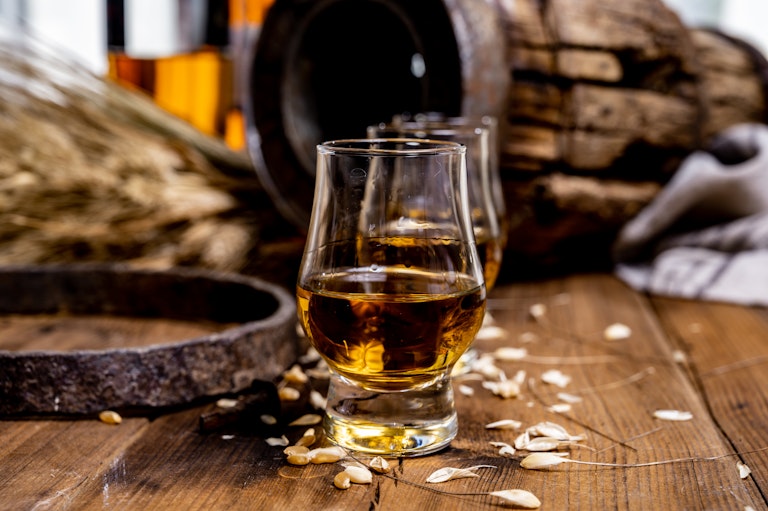Exploring whiskey takes you on exciting journeys of tastes, flavors, and aromas. Suppose you haven’t spent much time comparing some of the different whiskies you’re drinking and making some whiskey-tasting notes. In that case, it can be helpful to break down the various flavors and aromas of whiskies to understand which generally produce which whiskey flavors and what elements influence those tastes and flavors.
While there are certainly more than four types of whiskey, we will examine what many consider the big four whiskey grains in the states: bourbon, rye, wheat, and barley. Each has its distinct flavor profiles, and understanding those profiles will help you better understand what you like and what you want to drink.
Bourbon Whiskey Tasting Notes
Bourbon is probably one of the most prolific American whiskies and is often where most people start when they are introduced to whiskey. With its popularity comes a wide variety of bourbons with dramatically different whiskey flavor profiles.
While one bourbon can be significantly different than another, they have common ingredients and methods that must be followed for it to be called bourbon. Understanding these key components will better help you understand what you are tasting when comparing one to another.
To start, for bourbon to be classified as bourbon, it must be made with at least 51% corn. Corn, by its nature, is sweet, and that will translate into the whiskey and is often the source of the vanilla flavors often associated with bourbon.
Another requirement to be classified as bourbon is that it must be aged in new, charred oak barrels. Much of the flavors in the aging process come from the oak. One taste some people notice is “toasted oak,” which makes sense given the oak is charred.
Some of the other whiskey tasting notes you may find in your bourbon are what we perceive as:
- Sweet, nutty notes; often associated with walnuts or almonds
- Butter or caramel notes
- Caramel or maple notes
- Peppery or smokey notes
- Clove or nutmeg notes
- As mentioned before, vanilla notes.
Some bourbons that are matured for more extended periods may also produce cocoa notes.

Rye Whiskey Tasting Notes
Rye whiskey is probably the second most common American whiskies and has very different whiskey tasting notes and whiskey flavors than its cousin, bourbon.
Like bourbon, for rye whiskey to be classified as rye, it must be made with at least 51% rye. Also, like bourbon, rye whiskey needs to be aged in new, charred oak barrels. The big difference between the two in creating different whiskey flavors is the rye and corn.
While bourbon is often mixed with other grains, like wheat and barley, some ryes are made of 100% rye, which is considered more old school. In general, rye whiskey is considered drier on the palate than its sweeter cousin, bourbon.
The whiskey tasting notes you may notice in your rye are what we recognize as:
- Spicier, zippier notes that produce a peppery bite
- Sour notes, as you might taste in rye bread (they are both rye, after all.)
- Because of the oak barrels, you’ll notice some caramel notes
- And for the same reason, you may taste some vanilla notes, but usually not as prominent as bourbon.
Rye is generally considered less full-bodied, spicer, and drier than bourbon. Many prefer these tastes over bourbon.
Wheat Whiskey Tasting Notes
Wheat whiskies weren’t very popular but have made their way into the more popular whiskies because of their unique whiskey flavors. Almost all wheat whiskies are made in the US.
Wheated whiskies can be much smoother than others, especially rye whiskey. They can be a great place to start for someone new to whiskey, as they go down very easily.
The whiskey tasting notes you may discover when enjoying wheat whiskey are:
- Notes of honey and vanilla
- Toffee flavors
- Some notes of spice
- And hints of dried berries
Many bourbons are mixed with wheat, so you may find it makes the bourbon a bit smoother to drink and perhaps a little more complex in flavors and aromas.
Barley Whiskey Tasting Notes
Barley whiskies are going to be quite different than the other American whiskies. Barley generates whiskey flavors that are more commonly associated with Scotch whisky (yes, that’s spelled correctly. Scotch whisky doesn’t use the “e”).
Barley can pack more punch than its American cousins as it is malted and often dried with peat which adds earthy, smoky flavors and aromas. If you like whisky that is drier on the palate and a bit stronger, barley may be a place to start.
The whiskey tasting notes you will detect when sipping barley whiskey are:
- Notes of dried fig
- Caramel
- Orange rind notes
- And notes roasted toffee
Barley is often mixed with other grains to produce different flavors. And you’ll notice the difference because of the unique characteristics that barley brings to whiskey.
The enjoyable part of exploring different whiskies is that they all are different, have their own flavors and aromas, and present themselves in distinct ways on your palate.
Designer Dram’s whiskey maker includes barrels that contain each of the grains listed above, so you have the opportunity to mix them to your taste to create your unique bottle of whiskey. Start experimenting today and choose the flavors that excite you!



